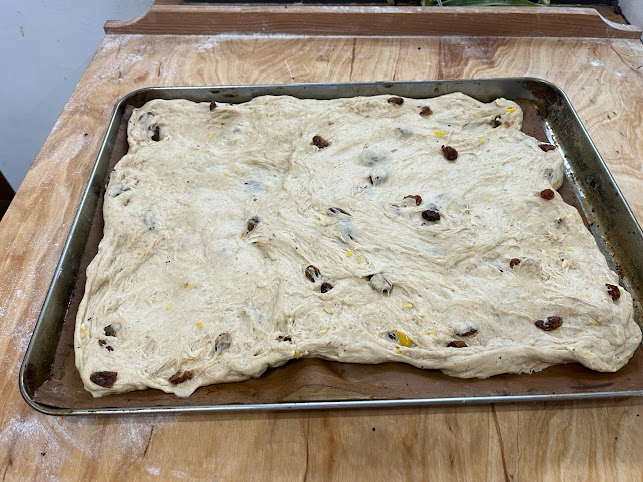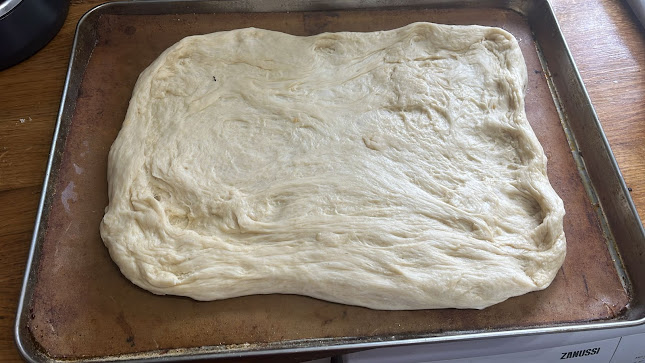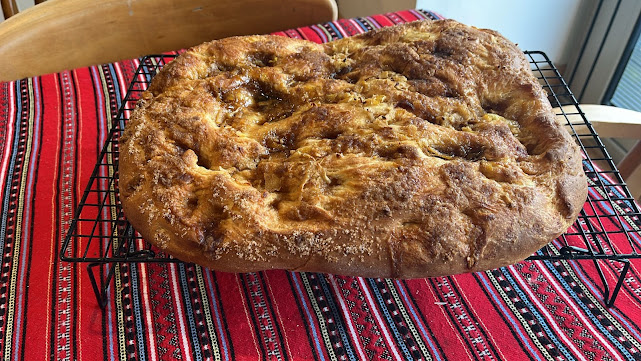Welcome to another step-by-step recipe from BreadClub20. Why not drop by our main Facebook page by clicking here.... If you like what you see and enjoy the recipe, we hope you join us by 'Liking' and 'Subscribing'
Strictly speaking, 'Focaccia' is a flat-leavened, oven-baked, Italian bread that invariably is served well-coated in the finest olive oil and dotted with herbs and sea salt.
Now, let's consider a delicacy from nearby Germany....the Butterkuchen is a butter 'cake', leavened with yeast. It has tell-tale holes dotted over the surface, rather like the focaccia, but instead of herbs, and olive oil, butter is used to dot the surface of the crust and then the whole butterkuchen is sprinkled with sugar. It's popular in Westphalia and Northern Germany, where it's often served for afternoon tea or for funeral wakes.
So, is it a Focccia or a Zuckerkuchen? Certainly, the focaccia, as a bread, dates back to the 14th century and predates the 'kuchen' by many hundreds of years. It's not beyond the imagination to see how the Italian focaccia could have migrated north across the Alps and begun the change from savoury to sweet.
Anyway, here are two recipes......you decide!
Oh, before I forget.... remember that these are enriched doughs. they will take longer to proof than ordinary 'lean' dough
So - I present you with TWO step-by-step formulae and processes.
- The first is adapted from Mary Pieter's Marmalade Focaccia or Kuchen. It hailed, originally, from Cleveland, Ohio and dates from 1941.
- The second is solely mine....a lemon zest, root ginger, butter and sugar kuchen in the spirit of a Dutch-Germanic-South African bread that an Oma might have baked.
NUMBER 1: BASED ON
MRS MARY PIETER'S
MARMALADE KUCHEN
Meet Mrs Mary Pieter or Cleveland, Ohio. Now, Pieter was her married name, a name that is of Scandinavian origin, but interestingly, also Dutch.
It's not a huge genealogical leap to see how 'Pieter' could easily be Germanic, Dutch or....through immigration or colonisation, American or even South African. In fact, there's an extensive family presence in Cleveland, Ohio.
But, what has that to do with foccacia, butterkuchen or even marmalade?
Back in 1941, Mrs Mary Pieter submitted her favourite recipe for a book being compiled by Lois Linton Sumption and Marguerite Lintner Ashbrook.
Sumption and Ashbrook were prodigious compilers of recipes from around the World and published many books in their lifetimes.
Tucked away in one of them, is Mary Pieter's favourite: 'Marmalade Kuchen'. On closer inspection, it's a bread, not a cake and it's leavened with yeast and enriched with butter. To all intents and purposes, it's a sweet focaccia.
It bears such a close resemblance to a focaccia, that it's easy to see how it may well have been an Italian bake that somehow made its way North, across the Alps and into Germany where it became a sweetened butter bread.
From there, it's extremely feasible to imagine it making its way west to Holland, east to Eastern Europe and taking the 'short hop' across to the United States or South Africa.
The rest is down to genealogy and 'family favourites'.
In the first trial, I stuck very much to the letter of the original recipe. The result was quite 'bready' and a little heavy. For the second trial, and the one presented below, I took Mary Pieter's 1941 recipe and adapted it to include a second proof and focused more on producing a thinner bake with more topping...
INGREDIENTS
500 gms of strong white bread flour
270 gms tepid milk
50 gms of caster sugar
30 gms unsalted butter
5 gms crushed sea salt
1 medium egg (beaten = about 50 gms)
7 gms instant active yeast.
A Note so far...
This is very much your 'base'. You're free to start adding 'options'.
If you wish, you can add some raisins or sultanas and/or some candied peel to the dough at the end of the first mix and while kneading. You can also add a little mixed spice to the ingredients if you wish.
How much?
Well, I added 100 gms of sultanas, the zest of a lemon, a little grated root ginger and a teaspoon of mixed spice.
But you can add as little or as much as works for you....of whatever takes your fancy.
for the topping
60 gms unsalted butter (softened and diced)
Chunky cut marmalade
20 gms dark sugar
(If you're using dried yeast or fresh yeast...activate it first using a little of the milk and a sprinkle of the sugar)
METHOD
In a large bowl, place the flour, yeast, salt, and sugar. Mix well.
Slowly add the milk and bring it together. Add the beaten egg and butter and stir well.
(Now is the time to add any 'options')
Knead until you have a smooth dough.
Tip the dough out into a lightly oiled bowl, cover and place in a warm place until it has doubled in volume.
Prepare a long shallow pan. Grease it well.
Tip the dough out onto a lightly floured board. Gently stretch or roll it out into a large rectangle
(I spray a cake release onto my board to help and to avoid using any extra flour)
Place the dough into the pan and stretch it to fit.
How long it takes to rise will depend on the temperature. Watch the dough, not the clock. This is an enriched dough....it takes longer than 'lean' dough.
Preheat the oven to 190⁰C. (FAN)
Cover and leave to rise until doubled.
When doubled, carefully and gently smear the top of the dough with thick-cut marmalade. Alternatively, you can put blobs of marmalade at regular intervals and it will spread once it gets hot.
Distribute the diced softened butter over the surface of the dough, then, with your index finger, make indentations across the surface of the dough at 2-inch intervals.
Finally, sprinkle the surface with brown sugar.
Bake for 30 - 35 minutes until golden.
Remove from the tray and cool on a rack before slicing and eating.
NUMBER 2: MINE!
JUST LIKE OMA USED TO MAKE?
DEUTSCHER ZUCKERKUCHEN
INGREDIENTS
400 gms Tipo 00 flour (or as near equivalent as you can manage)
40 gms caster sugar
3 gms crushed sea salt
150 gms tepid milk
90 gms beaten eggs
80 gms softened unsalted butter
7 gms active yeast
for the topping
100 gms softened butter cut into small cubes
100 gms caster sugar
just a small pinch of salt
lemon or orange rind - finely diced
METHOD
Combine the flour, sugar and yeast. Mix well.
Add the butter and eggs and mix well.
Knead until you have a soft and silky dough.
Place in a lightly oiled bowl, cover and leave in a warm place until doubled in volume.
Prepare a baking tray and grease it well.
When the dough has doubled, tip it out onto the baking tray and gently stretch it out into a large flat rectangle.
Cover and leave for 30 minutes to second proof.
Meanwhile, preheat the oven to 180⁰C and mix together the sugar, lemon and salt.
When the dough and the oven are both ready, dimple the dough all over with your fingers and then distribute the softened cubed butter all over the dough.
I also added chopped lemon zest and finely chopped root ginger to mine.
Evenly spread the sugar, lemon and salt mixture over the dough and then bake for 20 - 25 minutes until golden brown. Any remaining butter will disappear as the dough cools.
When baked, remove from the tray and cool on a rack.
POSTSCRIPT
So, what did the taste-testers think?
After Trial 2 on Mrs Piter's bake (the one above is Trial 2), I asked the taste tester to critique the new bake:
So, the choice is yours.
Of course, once you have your base - your focaccia/kuchen - you're free to improvise...
- sprinkle the top with sugar to give a crunchy topping
- mix cinnamon into the sugar topping
- press flaked almonds, or blueberries or both into the topping
- what about dried fruit....or orange zest...or lemon zest....root ginger?
- what about saffron or cardamom?
The choice is yours....
Viel Spaß beim Backen....Veel bakplezier.....Lekker bak....Happy Baking.


.jpeg)















Comments
Post a Comment